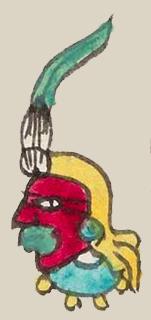Huei Pochtlan (Mdz8r)
This is a simplex hieroglyph for a place name, Huei Pochtlan. It shows a person's head. The hairstyle suggests it is a male, as does the "poch" (youth) element--perhaps having a similar origin as telpochtli, as pointed out by Frances Karttunen. He looks to the viewer's left. The face is primarily red, but with turquoise-blue lips and yellow hair. Horizontal black lines are painted or tattooed above and below the eye. Above the forehead is a long green feather (from a quetzalli, perhaps), a gray-brown eagle feather, and a white down feather ball. There is a turquoise ring where a necklace or collar might be, and it has small, white, pointy shapes (feathers?) hanging down off of the turquoise band.
Stephanie Wood
There was an Aztec deity with the name Opochtli ("The Left") who was associated with people who lived on the water, and he was known for fishing and hunting. The person in this glyph, if not a representation of the deity, could be a merchant. The place name has two elements, huei (for large or great) and pochtlan (merchantry). Alternately, the -tlan is the locative suffix (by or among), and the -poch- refers to youth. James Lockhart suggested that a Pochtecatl was originally just a person from Pochtlan, but the people from that community came to be famous as long distance traders. Eventually, the ethnic association with a given town gave way to an occupational label in general. [See: The Nahuas, 1992, 192.] The imagery of a very distinctive person's head would appear to have ethnic markers, such as the face and hair colors and the feathered headdress. The head in this glyph faces the opposite way from the other example we have for this place name, which may or may not have a significance.
Stephanie Wood
hueypochtlā, puo
Hueipochtlan, pueblo
Stephanie Wood
c. 1541, but by 1553 at the latest
markets, merchants, ethnicity, mercados, mercaderes, vendedores, pochteca, Hueypuchtlan, nombres de lugares

huei, great or large, https://nahuatl.wired-humanities.org/content/huei
-poch, youth (see telpochtli and ichpochtli), https://nahuatl.wired-humanities.org/content/poch
pochtlan, merchantry, https://nahuatl.wired-humanities.org/content/pochtlan
pochteca(tl), a long-distance merchant, https://nahuatl.wired-humanities.org/content/pochtecatl
-tlan (locative suffix), place, https://nahuatl.wired-humanities.org/content/tlan
-tla or -tlah (locative suffix), place of abundance of item, https://nahuatl.wired-humanities.org/content/tla-1
"Place of Great Opochtli." In her unpublished essay (shared with me) reviewing the work of Berdan and Anawalt in deciphering place names in the Codex Mendoza, Frances Karttunen adds this in her notes: "There seems to be a morpheme in ichpo:ch- 'young woman' and telpo:ch- 'young man' that may also occur in the deity names o:po:ch- and hui:zilo:po:ch-. It forms its plural by reduplication: po:po:ch-; cf. telpo:po:chtin 'young men' rather than simply tel.po:chtin.”
"Place of Great Opochtli" (Berdan and Anawalt, 1992, vol. 1, p. 188)
Codex Mendoza, folio 8 recto, https://digital.bodleian.ox.ac.uk/objects/2fea788e-2aa2-4f08-b6d9-648c00..., image 26, of 188.
Original manuscript is held by the Bodleian Libraries, University of Oxford, MS. Arch. Selden. A. 1; used here with the UK Creative Commons, “Attribution-NonCommercial-ShareAlike 3.0 License” (CC-BY-NC-SA 3.0)


